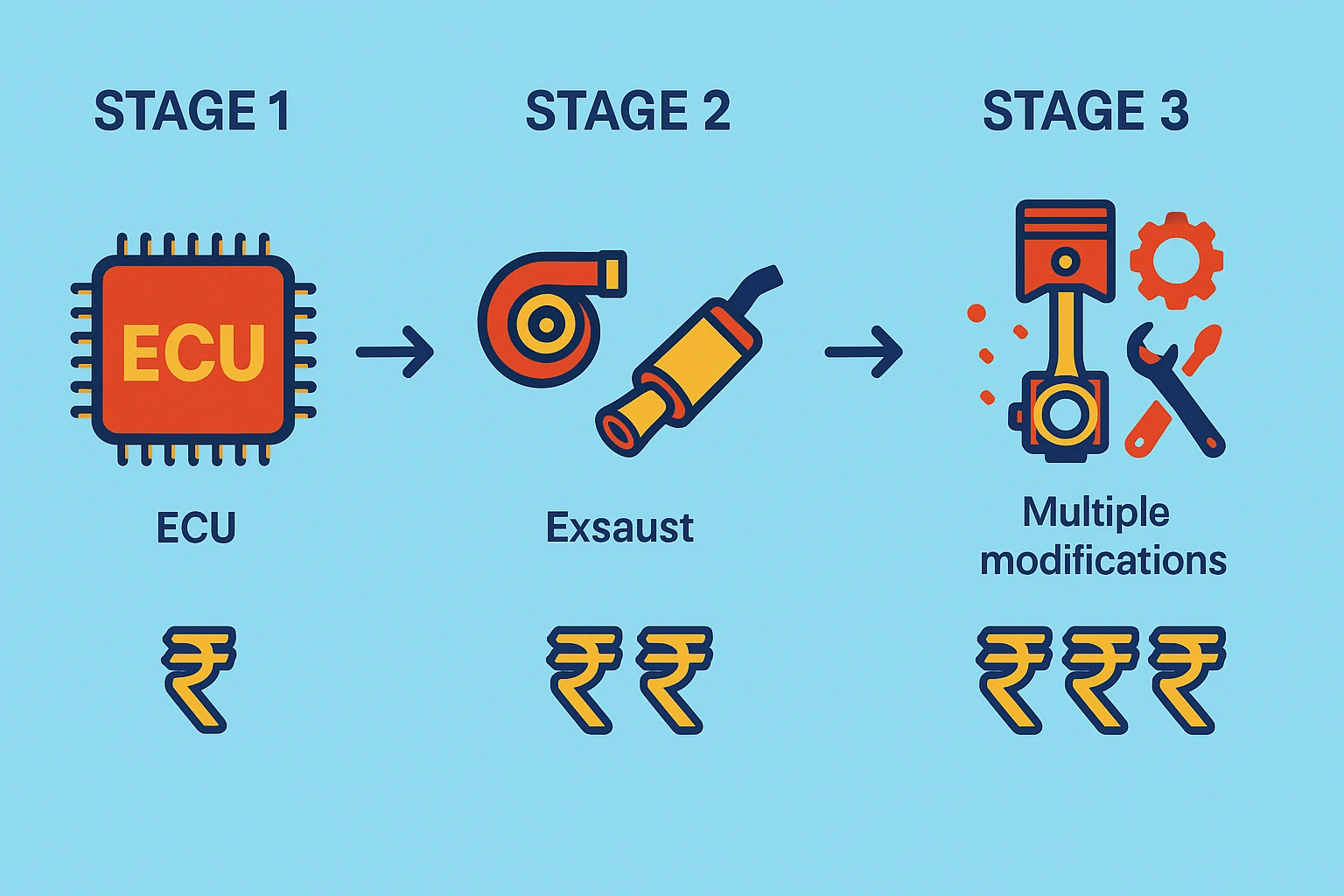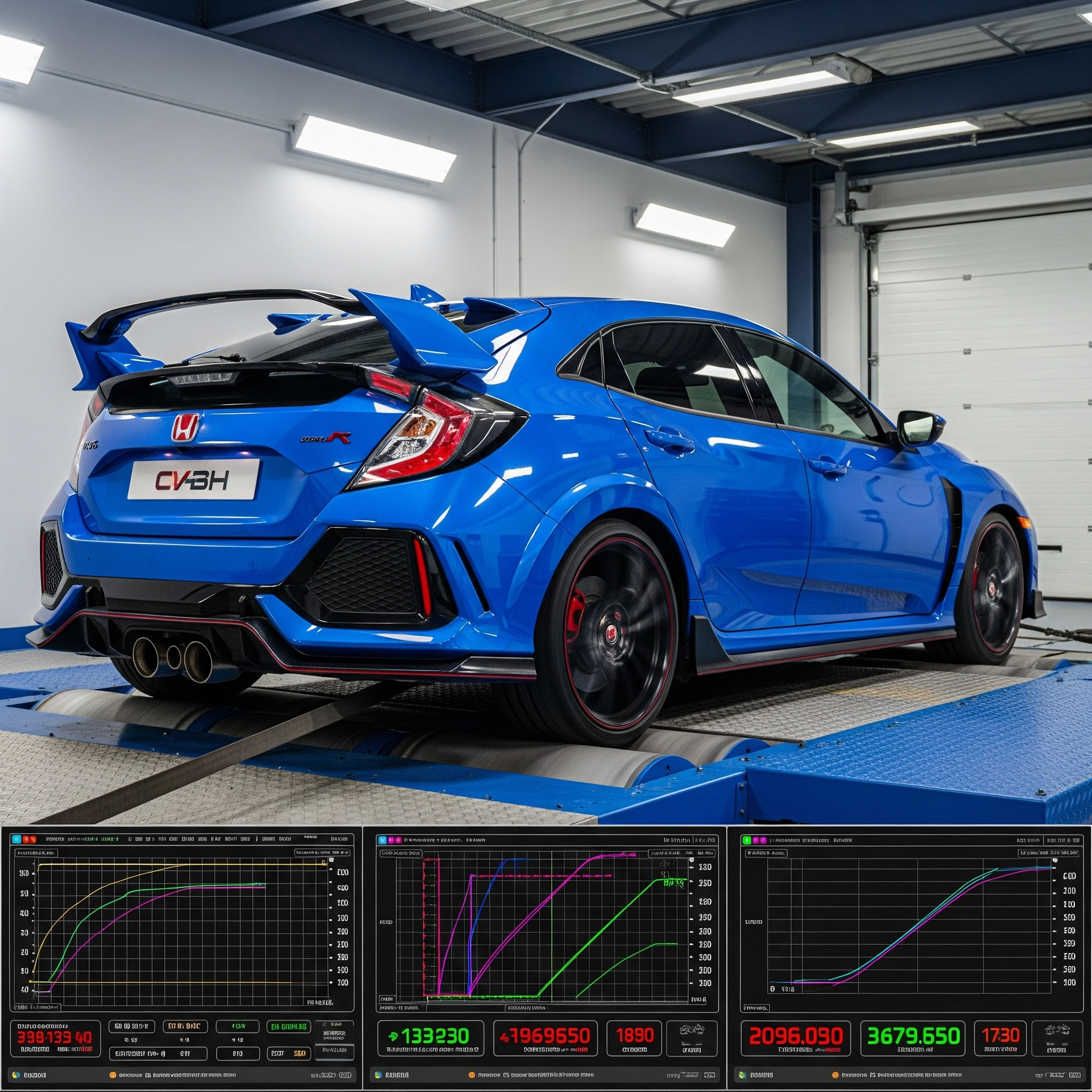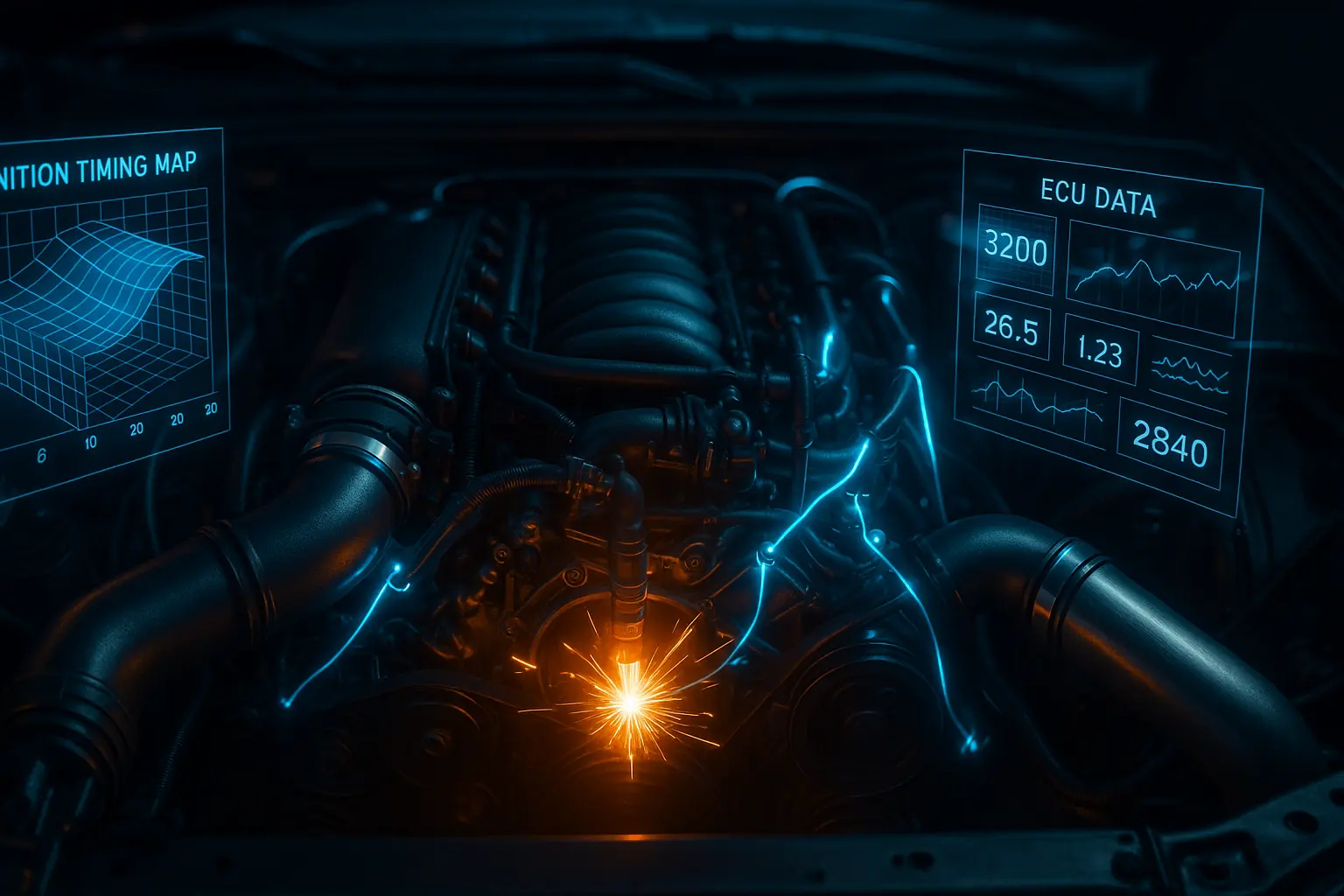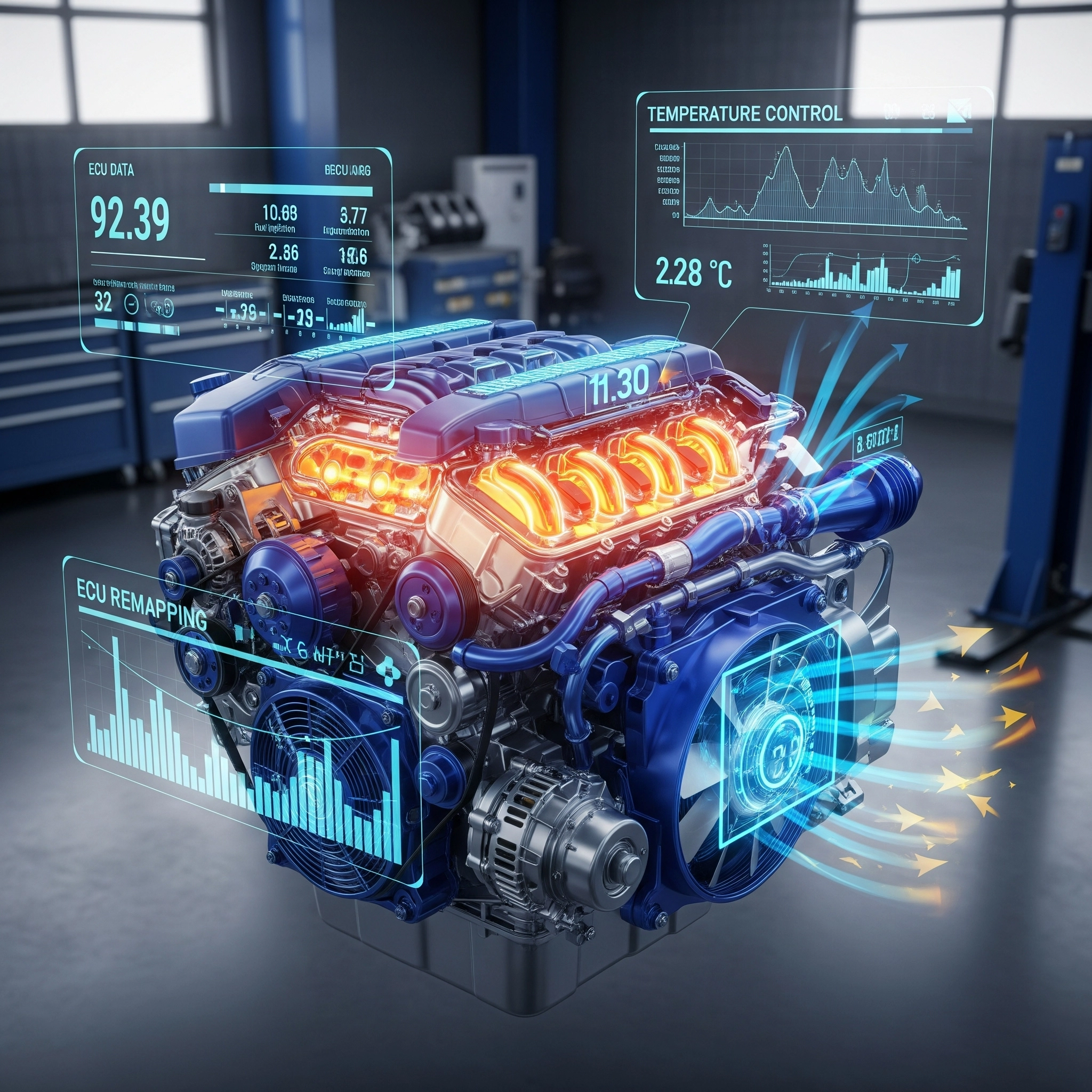What’s the difference between stage 1, stage 2, and stage 3 tuning?
When it comes to maximizing your vehicle’s performance, understanding tuning stages can unlock a world of power and efficiency. Whether you’re a seasoned car enthusiast or new to the tuning scene, the differences between Stage 1, Stage 2, and Stage 3 tuning are essential knowledge for anyone looking to enhance their driving experience. Stage 1 focuses on simple modifications that improve efficiency and minor horsepower gains, while Stage 2 dives deeper with more significant upgrades to the exhaust and intake systems to unleash additional potential. Finally, Stage 3 takes tuning to a whole new level, often involving extensive engine modifications for those seeking unparalleled performance. In this article, we’ll break down these three distinct stages, exploring what sets them apart, the benefits they offer, and how each can transform your ride into a powerhouse on wheels. Get ready to elevate your automotive journey and discover the tuning stage that’s right for you!
Unlocking Performance: Understanding the Key Differences Between Stage tuning
1, Stage 2, and Stage 3 Tuning
When it comes to maximizing your vehicle’s performance, understanding tuning stages can unlock a world of power and efficiency. Whether you’re a seasoned car enthusiast or new to the tuning scene, the differences between Stage 1, Stage 2, and Stage 3 tuning are essential knowledge for anyone looking to enhance their driving experience. Stage 1 focuses on simple modifications that improve efficiency and minor horsepower gains, while Stage 2 dives deeper with more significant upgrades to the exhaust and intake systems to unleash additional potential. Finally, Stage 3 takes tuning to a whole new level, often involving extensive engine modifications for those seeking unparalleled performance. In this article, we’ll break down these three distinct stages, exploring what sets them apart, the benefits they offer, and how each can transform your ride into a powerhouse on wheels. Get ready to elevate your automotive journey and discover the tuning stage that’s right for you!
What is Stage 1 Tuning?
Stage 1 tuning refers to the initial level of performance enhancement that can be applied to a vehicle. This stage involves relatively straightforward modifications that do not require extensive changes to the car’s hardware. Often, Stage 1 tuning focuses on optimizing the vehicle’s software settings and making minor adjustments to components like the air intake and exhaust systems. These changes aim to improve fuel efficiency, throttle response, and achieve modest increases in horsepower and torque.
Typically, Stage 1 tuning can be performed using an aftermarket tuning chip or an electronic control unit (ECU) remap. The process involves reprogramming the ECU to make better use of the engine’s existing capabilities. This could include adjusting the fuel-to-air ratio, ignition timing, and boost pressure in turbocharged engines. The modifications made during Stage 1 tuning are designed to be safe for the engine and other critical components, ensuring that the vehicle remains reliable for daily driving.
One of the main advantages of Stage 1 tuning is that it usually does not require any physical alterations to the engine or other key systems. This makes it a relatively cost-effective way to improve performance without the need for extensive mechanical work. Additionally, because these modifications are less invasive, they often do not void the vehicle’s warranty, making Stage 1 tuning an attractive option for many car owners looking to
enhance their driving experience.
Benefits of Stage 1 Tuning
The primary benefit of Stage 1 tuning is the noticeable improvement in vehicle performance. Drivers can expect enhanced throttle response, making the car feel more responsive and agile. This can lead to a more enjoyable driving experience, especially during daily commutes or spirited driving sessions. The modest increase in horsepower and torque can also provide a welcome boost in acceleration, making overtaking and merging onto highways smoother and safer.
Another significant advantage of Stage 1 tuning is the potential for improved fuel efficiency. By optimizing the engine’s performance, the vehicle can achieve better fuel economy under certain driving conditions. This can result in cost savings over time, as drivers may find themselves refueling less frequently. Additionally, since Stage 1 tuning often involves only software adjustments, it is generally a quick and straightforward process that can be completed in a short amount of time.
Stage 1 tuning is also an excellent entry point for car enthusiasts who are new to vehicle modifications. It allows them to experience the benefits of tuning without committing to extensive and potentially costly upgrades. The process is relatively risk-free and can provide a solid foundation for future performance enhancements. Overall, Stage 1 tuning offers a balanced approach to improving vehicle performance, making it an appealing choice for many drivers.
What is Stage 2 Tuning?
Stage 2 tuning takes performance enhancement to the next level by incorporating more significant modifications to the vehicle’s hardware. Unlike Stage 1, which primarily focuses on software adjustments, Stage 2 tuning involves upgrading components such as the exhaust system, intake system, and intercooler. These changes are designed to further optimize the engine’s performance and unlock additional horsepower and torque.
One of the key aspects of Stage 2 tuning is the installation of a high-flow exhaust system. This upgrade helps to reduce backpressure and allows the engine to expel exhaust gases more efficiently. As a result, the engine can breathe better and produce more power. Additionally, a high-flow intake system is often installed to improve the engine’s air intake, ensuring a more consistent and higher volume of air reaches the combustion chambers.
Another common modification in Stage 2 tuning is the addition of an upgraded intercooler, particularly for turbocharged engines. An intercooler helps to cool the compressed air before it enters the engine, which can significantly improve performance and reduce the risk of engine knock. By lowering the intake air temperature, the engine can achieve a denser air charge, leading to more efficient combustion and increased power output. Stage 2 tuning also often includes a remap of the ECU to accommodate these new hardware changes, ensuring that the engine operates optimally with the upgraded components.
Benefits of Stage 2 Tuning
Stage 2 tuning offers a more substantial increase in performance compared to Stage 1. The combination of hardware upgrades and ECU remapping can result in significant gains in horsepower and torque. This translates to faster acceleration, higher top speeds, and an overall more exhilarating driving experience. The improved exhaust and intake systems also contribute to a more aggressive engine sound, which many car enthusiasts find appealing.
In addition to the raw power gains, Stage 2 tuning can enhance the overall efficiency of the engine. The upgraded components work together to optimize the combustion process, leading to better fuel atomization and more complete burning of the fuel-air mixture. This can result in improved fuel economy under certain driving conditions, despite the increased power output. The enhanced efficiency also means that the engine can run cooler and more reliably, reducing the likelihood of overheating and other performance-related issues.
Stage 2 tuning also allows for greater customization and personalization of the vehicle. Car owners can choose from a variety of aftermarket components to suit their specific preferences and performance goals. Whether it’s selecting a particular brand of exhaust system or opting for a specific type of intercooler, the possibilities are vast. This level of customization can make the vehicle truly unique and tailored to the driver’s needs. Overall, Stage 2 tuning offers a comprehensive approach to performance enhancement, making it an attractive option for those looking to take their vehicle to the next level.
What is Stage 3 Tuning?
Stage 3 tuning represents the pinnacle of performance enhancement, often involving extensive modifications to the vehicle’s engine and other critical systems. This stage is typically reserved for serious enthusiasts and those looking to achieve the highest levels of performance. Stage 3 tuning can include a wide range of upgrades, such as forged internals, upgraded turbochargers or superchargers, high-performance fuel systems, and advanced engine management systems.
One of the defining features of Stage 3 tuning is the focus on strengthening the engine’s internal components. This may involve replacing the stock pistons, connecting rods, and crankshaft with forged versions that can withstand higher levels of stress and heat. These upgrades are essential for supporting the increased power output and ensuring the engine’s longevity under extreme conditions. Additionally, a high-performance fuel system, including larger injectors and fuel pumps, is often installed to provide the necessary fuel flow for the enhanced engine.
Another critical aspect of Stage 3 tuning is the use of advanced forced induction systems. This can include upgrading to a larger turbocharger or adding a supercharger to increase the amount of air entering the engine. These modifications can result in substantial gains in horsepower and torque, transforming the vehicle into a high-performance machine. To manage these changes, an advanced engine management system is often used to precisely control the engine’s operation and ensure optimal performance. This may involve custom tuning and dyno testing to achieve the best possible results.
Benefits of Stage 3 Tuning
The most significant benefit of Stage 3 tuning is the dramatic increase in performance. With the extensive modifications made to the engine and supporting systems, the vehicle can achieve levels of power and acceleration that are far beyond what is possible with Stage 1 or Stage 2 tuning. This can result in a truly exhilarating driving experience, with the ability to compete in high-performance motorsports or simply enjoy unparalleled performance on the road.
Stage 3 tuning also offers the opportunity for complete customization and personalization. Car owners can choose from a wide range of aftermarket components to create a vehicle that perfectly matches their performance goals and preferences. Whether it’s selecting a specific type of turbocharger, opting for a particular brand of forged internals, or choosing a custom exhaust system, the possibilities are endless. This level of customization allows for a truly unique and tailored driving experience.
In addition to the performance gains, Stage 3 tuning can also enhance the vehicle’s overall reliability and durability. The upgraded components are designed to withstand higher levels of stress and heat, reducing the risk of engine failure and other performance-related issues. This can provide peace of mind for car owners who push their vehicles to the limit, knowing that their engine is built to handle the demands of high-performance driving. Overall, Stage 3 tuning offers the ultimate in performance enhancement, making it the ideal choice for serious enthusiasts and those seeking the highest levels of power and efficiency.
Key Differences Between Stage 1, Stage 2, and Stage 3 Tuning
The key differences between Stage 1, Stage 2, and Stage 3 tuning lie in the extent of the modifications and the
level of performance enhancement achieved. Stage 1 tuning focuses on relatively simple and non-invasive changes, primarily involving software adjustments and minor hardware upgrades. This stage is designed to improve efficiency and achieve modest gains in horsepower and torque without requiring extensive mechanical work.
Stage 2 tuning takes performance enhancement a step further by incorporating more significant hardware upgrades, such as high-flow exhaust systems, intake systems, and intercoolers. These modifications are designed to optimize the engine’s performance and unlock additional power. Stage 2 tuning often requires more time and investment compared to Stage 1, but the results are more substantial in terms of performance gains.
Stage 3 tuning represents the most extensive level of performance enhancement, involving major modifications to the engine and other critical systems. This stage includes the use of forged internals, advanced forced induction systems, and high-performance fuel systems. The focus is on achieving the highest levels of power and acceleration, making Stage 3 tuning suitable for serious enthusiasts and those looking to compete in high-performance motorsports. The investment required for Stage 3 tuning is significantly higher than Stage 1 or Stage 2, but the performance gains are unparalleled.
Choosing the Right Tuning Stage for Your Vehicle
Choosing the right tuning stage for your vehicle depends on several factors, including your performance goals, budget, and intended use of the car. For those who are new to tuning or looking for a cost-effective way to improve performance, Stage 1 tuning is an excellent starting point. It offers noticeable gains in efficiency and power without requiring extensive modifications, making it a practical choice for daily driving.
If you’re looking for more substantial performance gains and are willing to invest in hardware upgrades, Stage 2 tuning may be the right choice. This stage offers a balanced approach to performance enhancement, with significant improvements in horsepower and torque. Stage 2 tuning is ideal for enthusiasts who want to take their vehicle’s performance to the next level without committing to the extensive modifications required for Stage 3.
For those seeking the ultimate in performance and are prepared for the investment, Stage 3 tuning offers unparalleled power and acceleration. This stage is suitable for serious enthusiasts and those looking to compete in high-performance motorsports. It involves major modifications to the engine and other critical systems, resulting in dramatic performance gains. However, it’s essential to consider the potential impact on the vehicle’s reliability and the need for ongoing maintenance and tuning.
Conclusion and Next Steps for Performance Enhancement
Understanding the key differences between Stage 1, Stage 2, and Stage 3 tuning is essential for anyone looking to enhance their vehicle’s performance. Each stage offers unique benefits and requires different levels of investment and commitment. From the relatively simple and cost-effective modifications of Stage 1 to the extensive and high-performance upgrades of Stage 3, there is a tuning stage to suit every driver’s needs and goals.
When considering performance enhancement, it’s important to assess your specific requirements and budget. Researching and consulting with experienced professionals can help you make an informed decision and ensure that the modifications are performed safely and effectively. Whether you’re looking for improved efficiency, significant performance gains, or the ultimate in power and acceleration, understanding the tuning stages can help you unlock your vehicle’s full potential.
Once you’ve chosen the right tuning stage for your vehicle, the next steps involve sourcing quality components and finding a reputable tuning shop to perform the modifications. Regular maintenance and monitoring are also crucial to ensure the longevity and reliability of the upgraded systems. By taking these steps, you can elevate your automotive journey and enjoy the enhanced performance and driving experience that tuning has to offer. Unlock the full potential of your vehicle and transform it into a powerhouse on wheels with the right tuning stage.





